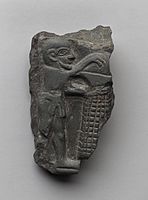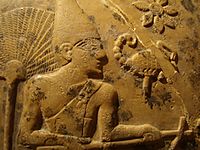Naqada III facts for kids
| Geographical range | Egypt |
|---|---|
| Period | Early Bronze I |
| Dates | circa 3,300 BC – circa 2,900 BC |
| Major sites | Naqada, Tarkhan, Nekhen |
| Preceded by | Naqada II |
| Followed by | Early Dynastic Period (Egypt) |

Naqada III was the final part of the ancient Egyptian Naqada culture. It lasted from about 3200 BC to 3000 BC. During this time, small kingdoms started to form and grow stronger. Kings began to rule these powerful areas.
People sometimes call Naqada III "Dynasty 0" or the "Protodynastic Period." This is because kings were in charge, even though they weren't part of a long family line (a dynasty) yet. These early kings' names were written in special symbols called serekhs. You can find them on pottery and inside tombs.
Contents
The Rise of Ancient Egypt
This period was a very important time for ancient Egypt. It saw many small areas slowly join together. This process eventually led to the creation of one big country. This single country then began the Early Dynastic Period.
It was also during Naqada III that the Egyptian language was first written down. This happened using hieroglyphs, which are picture-like symbols. Archaeologists have also found proof of Egyptian towns in southern Canaan. These were likely trading posts or small colonies.
How Egypt Became One Country
The idea of forming a single state started even before Naqada III. Many small city-states grew along the Nile River. Over hundreds of years, these smaller states fought and merged. Eventually, only three main states were left in Upper Egypt: Thinis, Naqada, and Nekhen.
Naqada was located between Thinis and Nekhen. It was the first of these three to be taken over. Then, Thinis conquered the areas of Lower Egypt. We are not sure how Nekhen and Thinis became one. They might have joined together peacefully. It seems the royal family from Thinis then ruled all of Egypt. These early kings were buried in a cemetery called Umm el-Qa'ab in Abydos.
Early Rulers
Many experts believe that Narmer was the last king of the Naqada III period. They also think he was the first king of the First Dynasty. Before Narmer, other kings might have ruled parts of Upper Egypt. These include kings like Crocodile, Iry-Hor, and Ka.
Another important ruler was possibly Scorpion II. His name might be linked to the goddess Serket. She was an early protector of gods and rulers.
Key Discoveries of Naqada III
The Naqada III period spread across all of Egypt. It was a time of many important firsts:
- The first hieroglyphs were used.
- The first stories told through pictures on palettes.
- The first regular use of serekhs to write royal names.
- The first truly royal cemeteries where kings were buried.
- Possibly the first example of irrigation to water crops.
There was also a notable second invention:
- The invention of sail navigation in Egypt. This idea came from the Persian Gulf, where it was invented about 2,000 years earlier.
In February 2020, Egyptian archaeologists found 83 tombs from the Naqada III period. These tombs contained small pottery pots, seashells, makeup tools, eyeliner pots, and jewels.
Decorative Palettes
Many beautiful decorative palettes come from the Naqada III period. One famous example is the Hunters Palette. These palettes were often used to grind makeup.
Other Important Artifacts
-
The Scorpion Macehead, found in the Ashmolean Museum.
See also
 In Spanish: Naqada III para niños
In Spanish: Naqada III para niños














